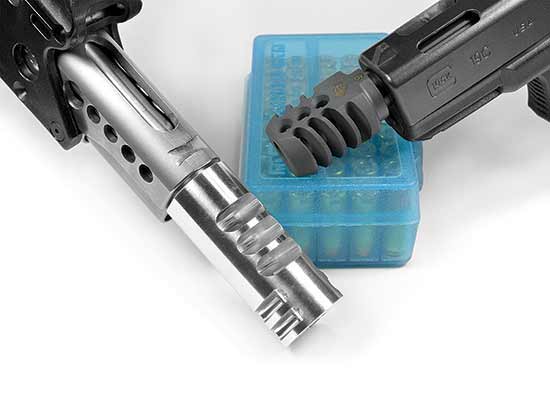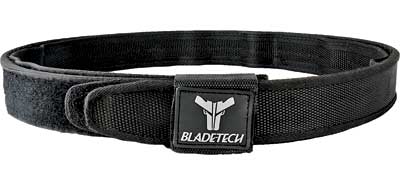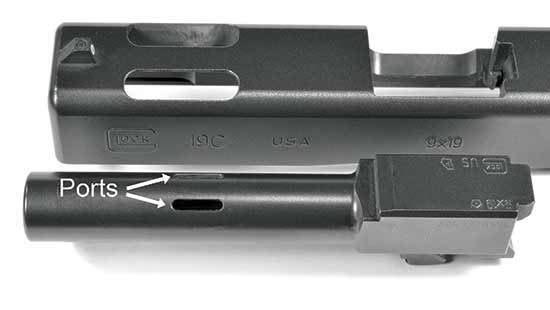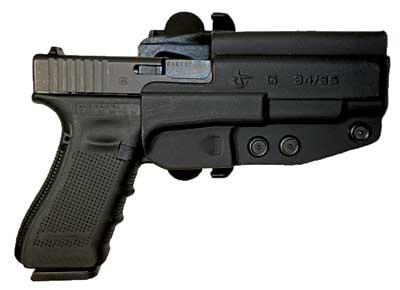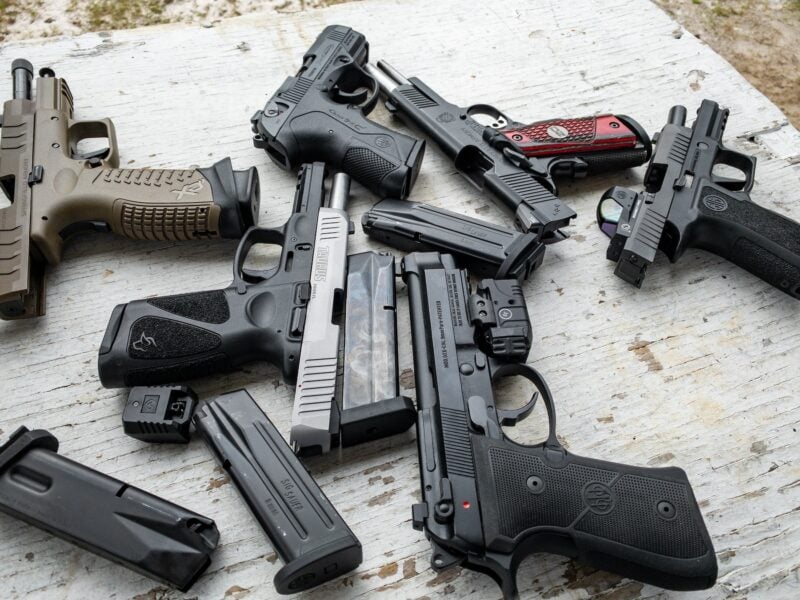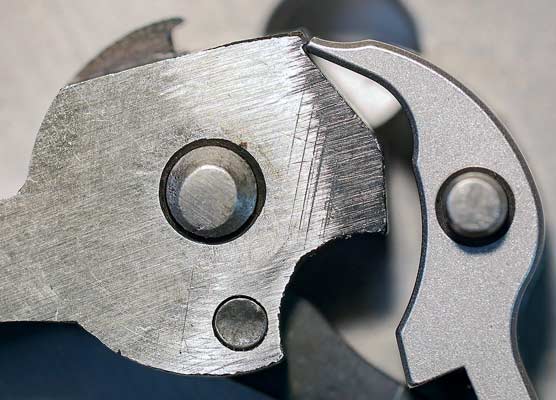Compensators: Do They Really Work?
Is It Myth And Magic Or Hard Science?
A compensator is the funny looking thing with holes in it attached to the end of the barrel. Its purpose is to reduce felt recoil and muzzle rise. And it does. But how does it do this?
Basically, a compensator (or comp) harnesses energy from the gas escaping after the bullet leaves the barrel. The high pressure gas pushing the bullet blasts out of the barrel at an even higher speed than the bullet is traveling. This gas contributes to the recoil force by way of the conservation of mass. The weight of the gunpowder contributes to the weight of everything leaving the barrel and must be added to calculations to arrive at the best estimate of recoil force. This explains why some gunpowders produce more recoil than other gunpowders even though they propel the same bullet at the same speed. The powder requiring more weight will produce more recoil force because there is more gas exiting the barrel.
The force of the gas pressure is directed forward. Thanks to Sir Isaac Newton, we know force directed in one direction produces an equal force in the opposite direction. So, the forward thrust of gas produces a rearward force on the gun adding to recoil.”
A compensator also adds weight to the moving parts, which also contributes to slowing down their rearward travel speed under recoil.
Getting Specific
Our sample comp is attached to a .38 Super barrel for a 1911-type pistol. It has three top ports and four side ports (two on each side). Each top port has an expansion chamber. The expansion chamber is wider than the passageway for the bullet. This is where the gas can expand and collect, as the bullet passes through. The chamber has a front wall, or baffle plate, to help redirect the gas. The side ports do not have an expansion chamber, but their front wall serves as a baffle.
When the high-speed gas hits the baffle plate, it pushes forward on the compensator. Whatever the compensator is attached to, such as the barrel, is also pushed forward. With many centerfire semi-auto pistols, the barrel and slide are locked together for the first few moments of the recoil cycle even as the slide starts to move to the rear when the bullet starts to move forward down the barrel. A 1911 operates this way. This means there is a counterforce produced by the gas hitting the compensator baffle(s), pushing the barrel/slide assembly forward to help counter their rearward movement. This slows down the slide and contributes to the reduction in felt recoil.
Slowing down the slide is not trivial in some guns. If there is sufficient forward force, the slide can be slowed down too much, and the gun won’t cycle reliably. This depends on the power of the ammunition (which mostly determines the recoil force), the amount of gas and its pressure, how many chambers (baffles) are on the compensator, the strength of the recoil spring and the weight of all the moving parts.
You might be familiar with some guns built for competition having slides with various patterns of holes cut in them. Besides looking awesome, this serves to reduce the weight of the moving parts, which can help increase reliable functioning when using a compensator.
The top ports on a compensator direct the gas upward. The upward flow of gas force is, once again thanks to Mr. Newton, countered by a downward force. This downward force reduces muzzle rise. Ta-Da.
Pressure?
QuickLOAD ballistic software (version 3.8) was used to estimate the gas pressure at the muzzle of generic loads in two handgun and two rifle cartridges. The gas pressure at the muzzle of a 9mm round in a 4″ barrel will be in the neighborhood of 5,000 psi. The gas pressure at the muzzle of a .45 Auto in a 5″ barrel will be in the neighborhood of 3,000 psi. The gas pressure at the muzzle of a .223 Remington in a 20″ barrel will be in the neighborhood of 8,000 psi. A .308 Winchester with a 24″ barrel will be in the neighborhood of 7,500 psi. The actual muzzle pressure will vary depending on the bullet, powder, charge weight and barrel length, but these numbers should give you a clue the pressure is very high! Compare it to the 40 psi of a car tire or the 200 psi in a high pressure air compressor tank.
Side ports deflect the gas laterally to reduce recoil. Any gas vented through the ports is no longer directed forward, so the total amount of gas force contributing to rearward recoil is reduced. Pistol shooters often say the side ports help to keep the gun stable and reduce wiggle. That said, many competitive pistol shooters use compensators without side ports.
Because compensators use gas force to work their magic, more gas often means more effective dampening of muzzle rise. Most pistol competitors load their own ammunition, so they can select different gunpowders to maximize the compensator’s effect.
Specific Load Magic
Slow gunpowders often require more weight to push the same bullet to the same velocity as fast powders, so slow powders are often the best choice for compensated pistols. You can check burn rate charts to see how powders rank, but the most important characteristic is how much weight is required to push the bullet to the desired speed. If you have two powders, and one requires six grains, and the other powder requires seven grains to meet your velocity requirement, the latter powder will produce less muzzle rise when fired through a compensated gun. This is just the opposite when you’re shooting a gun without a compensator. In this case, the powder requiring more weight will produce more muzzle rise since more gas mass is propelled forward.
Many competitive shooters spend considerable time in load development to find the right load to suit their particular shooting style and gun setup. The slowest powder might not be the best choice for them, and people have different opinions on what they like even when shooting the same gun.
Compensator Designs
Compensators come in a variety of designs and with varying numbers of expansion chambers and ports. The most effective compensator design has a small exit hole for the bullet. The reason for this is so the bullet acts like a “plug” as it passes through the baffle plate, because in doing so it allows the least amount of gas to pass around it and maximizes the amount of gas deflected onto the baffle plates and out of the port(s).
Another compensator design common for 1911-type pistols is a bushing-replacement compensator. This type replaces the barrel bushing, and therefore is attached to the slide. When the gun cycles, the barrel passes through the length of the compensator. This requires the exit hole be large enough to fit the width of the barrel, which is much larger than the bullet. The bullet is no longer a close fit to the exit hole, allowing a significant amount of gas to pass forward to add to the rearward recoil force. These designs are less effective than compensators with a small exit hole.
Ports
In addition to compensators, holes can be cut in the barrel to create ports venting the gas upward to reduce muzzle rise. The GLOCK 19C is an example. It has two ports cut into the barrel, side by side. Corresponding slots are cut in the slide. GLOCK refers to these guns as compensated models, but technically they are not compensators since they lack the expansion chamber and baffle.
Simply porting the barrel does reduce muzzle rise. The GLOCK 19C’s two small ports reduce muzzle rise almost as well as a single port compensator. Mag-na-port is famous for developing a process using EDM machining techniques to cut holes in barrels for this purpose.
Ports don’t reduce felt recoil as well as a compensator because there are no baffles for the gas to hit to slow down barrel and slide movement. Also, ports reduce the bullet’s velocity because they vent off gas pressure while the bullet is still accelerating down the barrel. But in most cases this reduction of velocity is very small.
Pros And Cons
Compensators can be very effective at reducing felt recoil and muzzle rise. This aids in getting the sights back on-target more quickly. Some shooters also feel compensators can help them reduce the chance of flinching due to the reduced perceived recoil.
Compensators have disadvantages, too. They add weight and length to a gun. They can be expensive and might require a threaded barrel. They might also require gunsmith installation, which adds to the expense. They usually increase the noise level, sometimes substantially.
Getting a compensated semi-auto pistol to function reliably might require using different ammunition, using a different gunpowder (in handloads), limiting the number of chambers, reducing the strength of the recoil spring (and possibly the hammer spring on appropriate guns), or reducing the weight of the moving parts. You can’t always just “screw one on” and go to work.
Compensators are not for everyone or every gun. They might be the perfect accessory for some shooters and certain types of competition where scores are based partly on time. Then, every fraction of a second spent getting follow-up shots changes your score. Whether they are practical or necessary often determines their utility.
But, like many things in life, the better designs are very effective at what they do.

